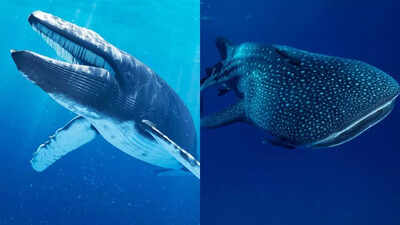ARTICLE AD BOX

When it comes to ocean giants, the blue whale and whale shark stand out as truly remarkable species. Both captivate scientists and marine enthusiasts alike due to their immense size and vital roles in aquatic ecosystems.
Despite sharing the “giant” label and being filter feeders, they differ significantly in classification, diet, and behaviour. Blue whales are marine mammals that primarily consume krill, while whale sharks are the largest fish, feeding on plankton and small organisms. Studying and understanding these differences enhances our appreciation of their ecological importance and emphasises the urgent need for their conservation and protection.
Which one is heavier and more massive: Blue Whale or Whale Shark
When it comes to sheer size, the blue whale holds the crown. As the largest animal ever known to have lived on Earth, it surpasses even the largest dinosaurs. Blue whales can reach lengths of up to 100 feet and weigh as much as 200 tons. To put this into perspective, their tongues alone can weigh as much as an elephant. Their hearts are about the size of a small car.

Whale sharks, while smaller, are still extraordinary. They are the largest living fish species, reaching lengths of up to 40 feet and weighing over 20 tons.
Despite their massive size, they are gentle filter feeders, primarily consuming plankton and small fish.

In summary, while the blue whale reigns supreme in size, the whale shark stands as a remarkable testament to the diversity of life in our oceans.
Evolutionary differences between blue whales and whale sharks
Although they share the name “whale,” blue whales and whale sharks are not closely related.Blue whales: Belonging to the marine mammal group of baleen whales, blue whales have existed for around 1.5 million years.
They primarily feed on krill and use a filter-feeding method via baleen plates to trap their food. Historically widespread, blue whales faced near-extinction due to whaling until protective bans were introduced in 1966. Today, they are classified as endangered.Whale sharks: These are ancient fish species, present in some form for approximately 265 million years. Whale sharks are the sole living members of the Rhincodontidae family.
Also, filter feeders rely on specialised filter pads to consume plankton, algae, and small crustaceans. Unlike blue whales, they are fish and share no direct evolutionary lineage with mammals.
Diets: How these giants sustain their massive size
Both species are filter feeders, but their feeding techniques differ.Blue whale diet: Blue whales are baleen whales, using keratinised baleen plates to filter krill from the water. They engage in “lunge feeding,” where they rapidly swim into dense swarms of krill, taking in massive volumes of water.
A single mouthful can contain up to 220 tons of water and krill. On average, blue whales consume around 2,469 pounds of krill daily to meet their caloric requirements.Whale shark diet: Whale sharks feed more passively than blue whales. They swim slowly through the ocean, allowing water to flow through their filter pads, trapping plankton, algae, and small crustaceans. Sometimes, they feed vertically near the surface to catch concentrated plankton.
Despite their size, whale sharks eat far less than blue whales in terms of absolute quantity.
Predators and threats
These ocean giants have few natural predators due to their massive size:Blue whales: Only killer whales can target young calves. Adults face threats mainly from human activities such as whaling, ship strikes, and the impacts of climate change.Whale sharks: Juveniles are vulnerable to predatory fish, but adult whale sharks are largely safe.
Human activity, including boat strikes and habitat disruption, poses the greatest risk.
Habitats and migration
Both species are widely distributed across the world’s oceans, but their habitats and migratory patterns vary:Blue whales: Found in all oceans except the Arctic, blue whales migrate seasonally between feeding and breeding grounds. Some populations remain in more static regions.

Whale sharks: Prefer waters above 70°F and are found in the Indian, Atlantic, and Pacific Oceans.
Around 75% of the population resides in the Indian Ocean, but sightings are recorded globally.

Conservation and importance
Both blue whales and whale sharks play critical roles in marine ecosystems. As filter feeders, they help regulate populations of krill, plankton, and small crustaceans, maintaining the balance of the ocean’s food web.Conservation efforts are vital:
- Protecting feeding and breeding grounds from human interference.
- Reducing threats from ship collisions and fishing nets.
- Raising awareness about their endangered and vulnerable status.
- Appreciating these giants underscores the broader importance of ocean conservation and highlights the impact of human activity on marine life
| Feature | Blue whale | Whale shark |
| Scientific Name | Balaenoptera musculus | Rhincodon typus |
| Type | Marine mammal, baleen whale | Fish, filter feeder |
| Maximum Length | Up to 100 feet (30.5 meters) | Up to 40 feet (12.2 meters) |
| Maximum Weight | Up to 200 tons (180,000 kg) | Up to 20.6 tons (18,700 kg) |
| Diet | Krill (tiny shrimp-like animals) | Plankton and small fish |
| Feeding Method | Filter feeding using baleen plates | Filter feeding through gill rakers |
| Habitat | All oceans except the Arctic; migratory | Tropical and warm-temperate seas; migratory |
| Conservation Status | Endangered | Endangered |



.png)
.png)
.png)
















 2 hours ago
4
2 hours ago
4







 English (US) ·
English (US) ·